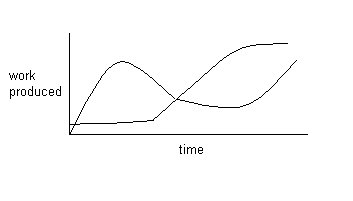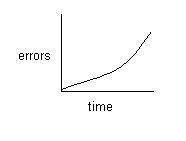CIS 375 SOFTWARE ENGINEERING
UNIVERSITY OF MICHIGAN-DEARBORN
DR. BRUCE MAXIM, INSTRUCTOR
Date: 9/29/97
Week 4
SOFTWARE QUALITY:
ASSESS QUALITY:
- Correctness;
- Maintainability;
- Mean Time To Change (MTTC).
- Spoilage = (cost of change / total cost of system).
- Integrity = [1 - threat * (1 - security)];
- Threat = probability of attack (something that
causes failure).
- Security = probability attack is repelled.
- Usability =
- Time to learn system.
- Time required to become proficient.
- Net productivity increase.
- Subjective attitude survey.
- DRE - defect removal efficiency;
- DRE = E / (E + D).
- E = the # of errors found before delivery.
- D = the # of errors found after delivery.
QUALITY:
- Of Design - characteristics of product specified by designer.
- Of Conformance - degree to which specifications were followed
during manufacture.
QUALITY ASSURANCE:
TOTAL QUALITY MANAGEMENT:
(TQM)
- Develop visible and repeatable processes.
- Examine intangibles affecting processes and optimize their
impact.
- Concentrate on user's application of the product and improve
the process.
- Examine uses of product in the market place.
SOFTWARE QUALITY ASSURANCE:
- Software requirements conformance - is the basis for measuring
quality.
- Specified standards define developmental criteria and guide
software engineering process.
- There is an implicit set of requirements which must be met.
SOFTWARE QUALITY ASSURANCE GROUP:
Duties:
- Prepare SQA plan.
- Participate in developing project software description.
- Review engineering activities for process compliance.
- Audit software product for compliance.
- Ensure product deviations are well documented.
STRUCTURED WALKTHROUGH: (DESIGN
REVIEW)
Peer review of some product - found to eliminate 80% of all
errors if done properly.
WHY DO PEER REVIEW?
- To improve quality.
- Catches both coding errors and design errors.
- Enforce the spirit of any organization standards.
- Training and insurance.

FORMALITY TIMING:
Formal presentations - resemble conference presentations.
Informal presentations - less detailed, but equally
correct.
Early - informal (too early, may not be enough
information).
Later - formal (too late, may have a "bunch
of crap").
When?
~ After analysis.
~ After design.
~ After compilation (first).
~ After test run (first).
~ After all test runs.
ROLES IN WALKTHROUGH:
- Presenter (designer/producer).
- Coordinator (not person who hires/fires).
- Secretary (person to record events of meeting,
build paper trail).
- Reviewers
- Maintenance oracle.
- Standards bearer.
- User representative.
GUIDELINES FOR WALKTHROUGH:
- Keep it short (< 30 minutes).
- Don't schedule two in a row.
- Don't review product fragments.
- Use standards to avoid style disagreements.
- Let the coordinator run the meeting.
FORMAL APPROACHES TO SQA:
- Proof of correctness.
- Statistical quality assurance.
- Collect/categorize sample.
- If defects are found trace them back to the code
- Clean room process (combine #'s 1 & 2).
SOFTWARE RELIABILITY:
Measures:
MTBF - mean time between failures.
= MTTF (mean time to failure) + MTTR (mean time to repair).
Availability = MTTF / (MTTF + MTTR) = (MTTF / MTBF) * 100%.
RELIABILITY MODELS:
- Predicts reliability as a function of chronological
time.
VS
- Predicts reliability as a function of elapsed processor time.
RELIABILITY MODELS THAT ARE DERIVED FROM HARDWARE RELIABILITY
ASSUMPTIONS:
- Debugging time between errors has exponential
distribution - proportional to # of remaining errors.

- Each error is removed as it is discovered.
- Failure rate between errors is constant.
MODELS DERIVED FROM INTERNAL PROGRAM CHARACTERISTICS
SEEDING MODELS:
Take errors and arbitrarily place them into the
code, to see how long it takes to catch the seeded errors.
CRITERIA FOR EVALUATING MODELS:
- Predictive validity.
- Capability (produce useful data).
- Quality of assumptions.
- Applicability (can it be applied across domain
types).
- Simplicity.
Date: 10/1/97
Week 4
MAINTENANCE:
(Longest life cycle phase)
EVOLVING SYSTEM VS. DECLINING:
- High maintenance cost.
- Unacceptable reliability.
- System adaptable to change?
- Time to effect change.
- Unacceptable performance.
- System functions limited in usefulness.
- Other systems? (faster, cheaper).
- High cost to maintain hardware.
MAINTENANCE TEAM:
- Understand system.
- Locate information in documentation.
- Keep system documentation up to date.
- Extend existing functions.
- Add new functions.
- Find sources of errors.
- Correct system errors.
- Answer operations questions.
- Restructure design and code.
- Delete obsolete design and code.
- Manage changes.
TYPES OF MAINTENANCE:
- Corrective (21%) fixing errors in original product.
- Adaptive (25%) fixing errors created by fixing other errors.
- Perfective (50%) client needs changes.
- Preventative (4%) prevent new errors.
MAINTENANCE DIFFICULTY FUNCTIONS:
- Limited understanding of hardware and software (maintainer).
- Management priorities (maintenance is low priority).
- Technical problems.
- Testing difficulties (finding problems).
- Morale problems (maintenance is boring).
- Compromise (decision making problems).
MAINTENANCE COST FACTORS:
- Type supported applications.
- Staff turnover.
- System life span.
- Dependence on changing environments.
- Hardware characteristics.
- Quality of design.
- Quality of code.
- Quality of documentation.
- Quality of testing.
CONFIGURATION MANAGEMENT:
(Tracking changes)
CONFIGURATION MANAGEMENT TEAM:
- Analysts.
- Programmers.
- Program Librarian.
CONFIGURATION CONTROL BOARD:
(Change control board)
- Customer representatives.
- Some members of the Configuration management team.
PROCESS:
(Of changes)
- Problem is discovered.
- Problem is reported to configuration control board.
- The board discusses the problem (is the problem a failure
or an enhancement, who should pay for it)
- Assign the problem a priority or severity level, and assign
staff to fix it.
- Programmer or analyst locates the source of the problem, and
determines what is needed to fix it.
- Programmer works with the librarian to control the installation
of the changes in the operational system and the documentation.
- Programmer files a change report documenting all changes made.
ISSUES:
(Of change process)
- Synchronization (when?).
- Identification (who?).
- Naming (what?).
- Authentication (done correctly?).
- Authorization (who O.K.'d it?).
- Routing (who's informed?).
- Cancellation (who can stop it?).
- Delegation (responsibility issue).
- Valuation (priority issue).
AUTOMATED TOOLS FOR MAINTENANCE:
- Text editors (better than punch cards).
- File comparison tools.
- Compilers and linkage editors.
- Debugging tools.
- Cross reference generators.
- Complexity calculators.
- Control Libraries.
- Full life cycle CASE tools.
COMPUTER SYSTEM ENGINEERING:
- Software Engineering.
- Hardware Engineering.
COMPUTER SYSTEM ELEMENTS:
- Software.
- Hardware.
- People.
- Databases.
- Documentation.
- Procedures (more human type, not code).
COMPUTER SYSTEM ENGINEER/ANALYST TASKS:
- Transform customer defined goals and constraints into a system
representation describing:
- Function.
- Performance.
- Interfaces.
- Design constraints.
- Information structures.
- Bound the system and select the configuration using:
- Project schedule and costs.
- Business considerations.
- Technical analysis.
- Manufacturing evaluations.
- Human issues.
- Environmental interface.
- Legal considerations.
SOFTWARE ENGINEERING:
- Definition phase:
- Produce software project plan.
- Produce software requirements plan.
- Revised software project plan.
- Development phase:
- Deliver first design specifications.
- Module descriptions added to design specs after review.
- Coding after design is complete.
- Verification, release, and maintenance:
- Validation of source code.
- Test plan.
- Customer testing and acceptance.
- Maintenance.
HUMAN FACTORS AND HUMAN ENGINEERING:
(HCI - human computer interaction)
- Activity analysis (watch the people you're supporting).
- Semantic analysis and design (what & why
they do things).
- Semantic and lexical design (hw & sw implementation).
- User environment design (physical facilities
and HCI stuff).
- Prototyping.


